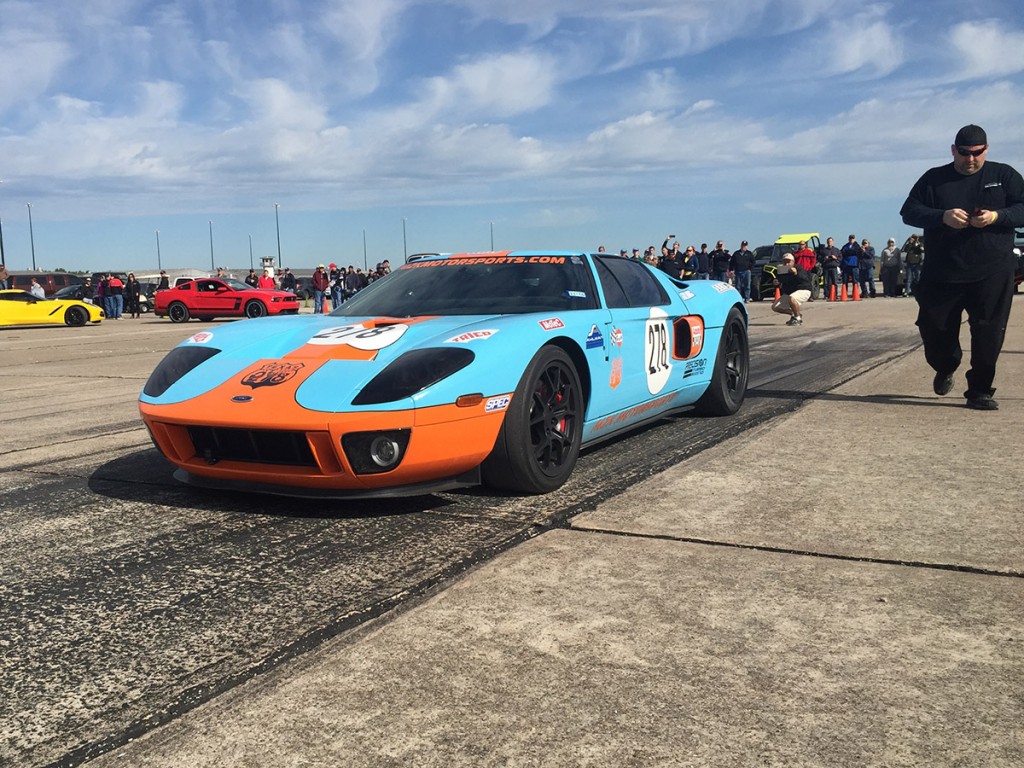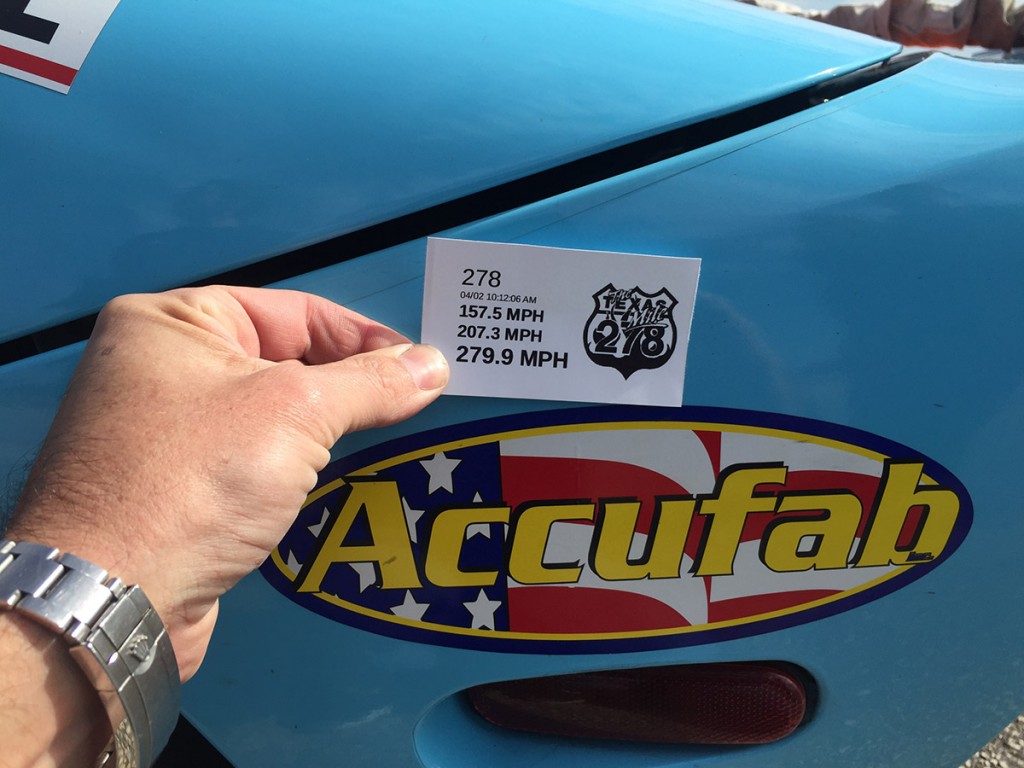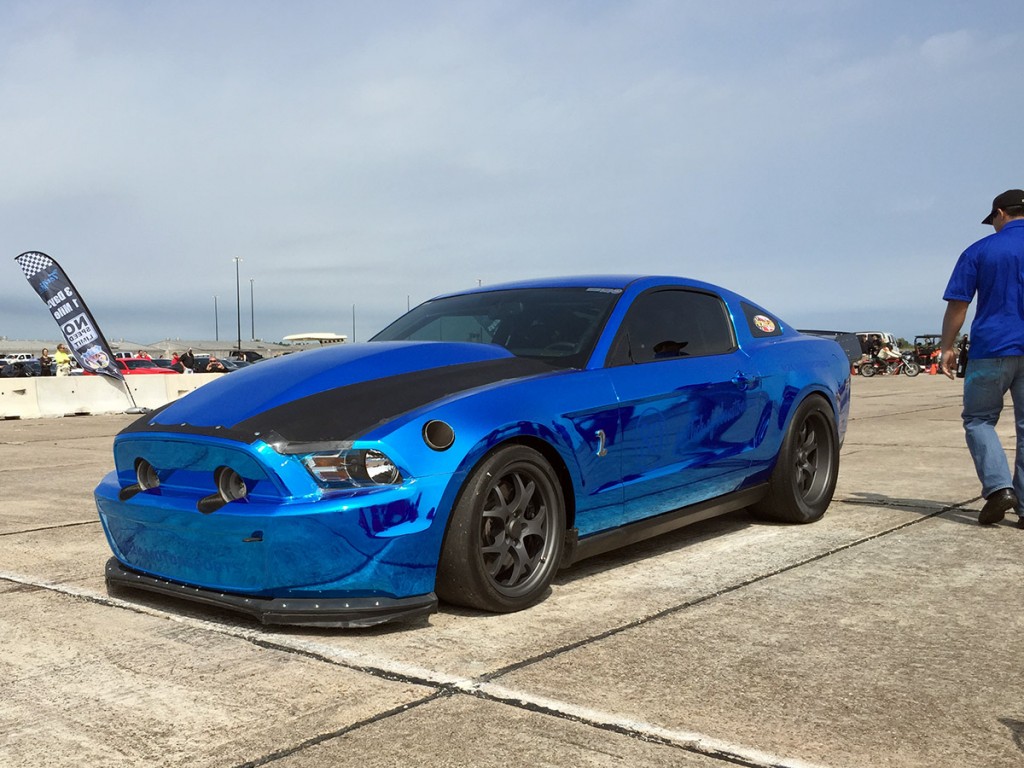On April 2, the Ford GT owned by Ford GT Forum member and M2K Motorsports partner Mark Heidaker set a new Texas Mile record with an astonishing run of 279.9 mph. We caught up with Mark to get his thoughts on what it’s like to own, build and race the car that owns the Texas Mile.

You already owned the Texas Mile record with a previous run of 278.2 mph. How satisfying is it to break your own record, especially when you’ve basically run everyone else out of the competition?
Back in 2011, when we attended the Ford GT Rally in Austin, I met a good friend, Mr. Ray Hofman. Ray had this unbelievable car built with an AccuFab motor, and I was there with a Twin Turbo/Supercharged 2006 GT. I had never been involved with Mile racing but very quickly it piqued my interest.
I’ll never forget when Ray showed up in his Yellow/Black stripe GT. It sounded like nothing I had ever heard before. Right then and there, I was hooked. We were only able to run in the mid 220’s but what a blast we had. Watching Ray better his time every time they ran the car just got more exciting.
After that event, I decided I wanted to build a GT that would run 235+ and that’s where it began. In March of 2012, the Texas Mile record was 255 mph, and I never really thought we would achieve that. To my surprise we were able to run 257.7mph and take the Texas Mile Record.
In October 2012, we bettered the record and ran 263.3 mph. In March of 2013, we went faster and hit 267.6mph, but weren’t satisfied with that and came back in October of 2013 and ran what stood for a couple of years at the speed of 278.8mph.
For a little over a year and a half we decided to play with different configurations in the transmissions and thought an air shifter may be the safest route to see if 300mph in the mile was achievable. After 4 Mile events and not getting where we wanted, I decided to go back to the stock transmission to see about running it quicker than the 278.2 mph. We just did that and ran a personal best and new Texas Mile Record of 279.9mph.
We know the car has enough power to go much faster, but over the years we have been fighting the traction issues at the big end of the track. Even today, at speeds in excess of 250 mph, the car is still capable of spinning the tires and having the MoTec traction control work to keep the car straight.
Ultimately, it’s very satisfying to keep being able to break the record. I know 1.7 mph faster doesn’t seem like a lot, but we haven’t been faster than 278.2 since October 2013. At this level of speed, a little faster takes a lot more effort and strategy from the whole team. We’ve been testing a new transmission for the last few events which is a modified stock Ricardo transaxle that has been converted to air shift. We’ve had a lot of bugs to work through, but we feel like it is getting closer to being a reality. We feel at this point this will be the component that will take us to “the next level,” so to speak.
How is the car behaving at those speeds?
Amazingly well actually. We haven’t changed anything about the factory aerodynamics of the car. It is really amazing in stock form and is a testament to the great job Ford did building the GT.
Early on when we started getting to the higher speeds (260+), Patrick, the driver of the GT, commented that on the 4-5 shift the car would get a bit upset. This was due to the nose dropping and lifting again when he got back on the power. Pretty much at this point with the help of the shock data from the Motec and the help of Scott Ahlman, we figured out that the suspension was bottomed out from the down force and that was causing the issue.
We really owe the stability of the car at this level to both Scott and the original engineers at Ford that designed the car. Scott was able to build us a set of coilovers for the car that practically made the car behave at these speeds like driving down the freeway at 70 mph. Patrick said on the 279.9 run that the car was more stable at high speed than it ever has been after the last round of suspension re-valving.
What kind of power do you think the car was making on the record run?
We get that question a lot and the truth is it is somewhat of an educated guess. We’ve never chassis dynoed the car on full power. That said, the car has made in excess of 2000 rear wheel horsepower at 36 psi boost pressure. On the record run the Motec data showed a maximum boost level of 39 psi.
It is really hard to give an accurate number because there are other factors to consider,but at 40 psi our best guess is somewhere around 2,350rwhp. We have a boost pressure limit of around 45-48 psi, so we’re guessing we have the potential for about 2,5XX rwhp.

In the early days of the Texas Mile, 200 mph was a big deal. Now you’re killing that at the half in a car that’s geared for top end. When you started this build did you ever think you’d be thinking more about 300 mph than 200 mph?
We’ve talked about that a lot actually. We’d gotten to the point that at some of the outings between the 278.2 pass and now, we were bummed out if the car was going in the low 270s. It’s really crazy how things have evolved over the last several years.
This all started with the goal to go 235, and when we set that goal it felt like a huge number to overcome. Our best recorded half mile time has been 218 which is still far away from our original goal in the actual mile, not the half, but if you would have told us we would be doing mid 2 teens in the half back when we started, we would have probably gave you a interesting look to say the least.
They don’t exactly make road car tires speed rated for 280+. How often are you changing the tires?
We’ve used the Hoosier R6 up until this outing and now we’re using the Hoosier R7. We’ve had very good success with these tires thus far. They’re not the stickiest tires out there, but they’ve been proven time and time again to do well at these speeds. Knock on wood but that’s been one aspect of this journey we haven’t had a single issue with.
We normally change the tires every three full runs because after speaking with Hoosier, the most they will tell us is “the tire was not tested for those speeds.” It gets quite expensive quick, but our main priority is always safety first, so it’s just part of the game.
A lot of people comment on the sound of the car as it initially takes off. That’s the standalone ECU keeping the car from blowing away the tires correct?
YES!! LOL! If I had a dollar for every person on social media that comments about how bad the car is missing out, I would have a whole fleet of GT’s. But seriously, yes, it is the traction control in the Motec ECU.
At first when the car is sitting still the popping you hear is what is called “anti-lag”. That is a program in the computer to get the turbos spooled up and making boost sooner. After the car is in motion, that’s the traction control.
The way the traction control works is it initially will pull ignition timing, and if the tires continue to spin, it will pull boost. Lastly, it will start cutting spark to individual cylinders to control the wheel spin. All the breaking up and popping that you hear are the cylinders losing spark and firing back up again to control the wheel spin. We actually have Motec data that is reporting wheel spin in fifth gear at 250+ mph!
You also had a GT500 hit 232 mph last weekend. That seems like it would be a white-knuckle ride compared to the GT, no?
The driver of that car is actually the owner of the car, Billy Wagner. He told us it was actually a pretty stable ride at that speed.
That’s a project that M2K recently took on, and this was actually the first outing with the car after the redesign, from a previous shop that had worked on it. Having all the experience with the GT definitely helped give a good baseline to work with on the GT500.
We’ll be monitoring the car’s attitude as it goes faster and faster, but like the GT program, we plan to make small steps with every outing. At this time, the motor in the GT500 makes as much power as the motor in the GT, but no doubt the aerodynamics will be the limiting factor as we push the envelope. This GT500 now holds the record for the fastest Mustang at the Texas Mile with the speed of 232.8mph.

Do you see anyone or any other platform that’s willing to come out and put up a fight against the GT at the Texas Mile?
That’s a tough question to answer without sounding arrogant.
I wouldn’t want to say no, but I think it’s unlikely. The time it’s taken to get this far and the team that has been assembled to get there is just not describable. The amount of dedication and perseverance we’ve gone through to get the GT where it is today is just crazy.
I cannot say enough about everyone involved. John Mihovetz from Accufab on the engine, Naoto Negishi of NCS for the tuning and wiring, Kevin Kesterson from M2K on the building and maintenance, Patrick O’Gorman on driving duty, and all the rest of the people who have helped us along the way. Not one of us could make this happen without the entire team working together. It really is impressive, and for someone to try to get to this level in the near future would take a lot, to say the least.
Where do you go with the GT from here? Is there a specific end goal for the car?
We would really still like to go faster! Our immediate goal is to be able to reach 285 mph at the Texas Mile. We actually ran all the power the car had in it Sunday at the event to see what it would do and Patrick had to lift off the throttle several times in fifth gear to get the car lined back up.
The Motec data showed massive tire spin and .5 lateral G’s at 253 mph! We think 285 is achievable at the Texas Mile but don’t think that speed is safe at that particular location. For those of you that may have not been there, the track is very, very bumpy, especially at the top end. That’s not conducive to laying down huge amounts of horsepower in high gear.
That said, we learned a lot this outing just like we do at every outing and we’ll back in October to see what we can do. As long as we feel it’s safe to continue to push for faster and faster speeds, we’re all for trying to get to that 300 mph mark. No doubt the Ford GT platform is the one that will be able to do it.
What’s next?
Right now the engine is going to go back to John Mihovetz and Gary at Accufab for a couple of upgrades and a refresh. We’ve now went to 4 mile events running speeds of 267, 269, 273 and 279 without having to as much as take a valve cover off the engine! We cannot say enough about the quality of the engines that John builds and the Ford Modular 5.4L.
Of course we’ll give everything a good looking at while it is apart like we do between every event. We are still working on a long term transmission solution because at this point it has been somewhat of the achilles heel of the program. The stock transmission has gotten us to this point, but as we mentioned before, to get to the next level we’re exploring other options.
We have more failures there than anywhere else thus far, but we’re diligently working on a resolution. We may start to explore different venues in the mile racing scene too, such as Mojave and some of the other events being promoted around the states.
We know there is a certain venue that would allow the car to go much faster but only private runs are allowed. We believe in our roots and at M2K we want to run the number in front of a crowd to showcase how fast our Ford GT really is.
Thanks for taking the time Mark. Congratulations to you and the team at M2K, and we looking forward to more records to come.
Watch the record setting run below, and keep up with M2K Motorsports at http://www.m2kmotorsports.com

